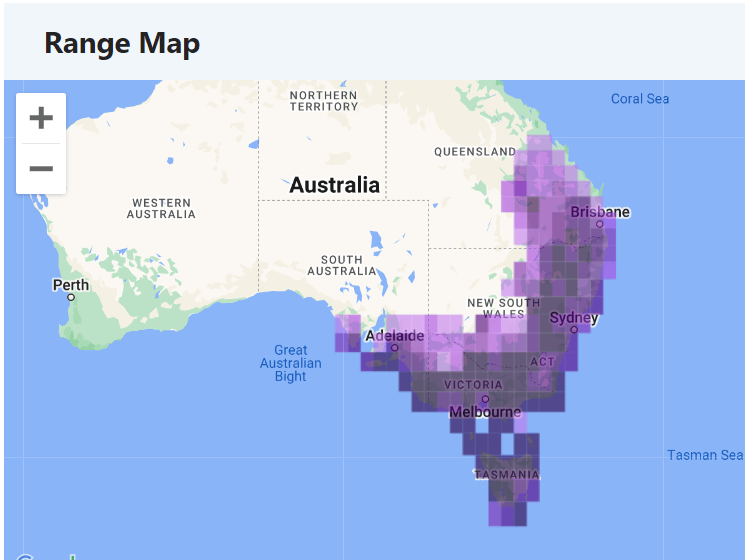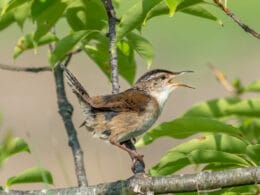Colorful birds metabolize carotenoids in plants and berries and that gives them vibrant feathers. Blue feathers? There is actually no such thing. Read on to find out why that is and explore our list of 15 black birds with blue heads found across the globe.
How are Blue Feathers made?
Carotenoids in plants and berries gives birds their vibrant feathers. Blue feathers are a little different. In fact, there is no such thing as blue feathers. There are a couple of theories as to how they are created but is seems to be because of light scattering. Microscopic pockets containing the protein keratin sit inbetween the feathers. The wavelength of the blue part of light is similar to the structure of these pockets and so, it doesn’t pass through but is reflected straight to us. This is why these birds only look blue or iridescent some of the time.
Black Birds with Blue Heads
As we come to our choice of black colored birds with blue heads, it should be noted that there are actually very few birds that fall strictly within that category. It maybe something to do with light scattering, we are not really sure. Included on our list are birds that are partly black, partly blue and sometimes other colors.
Common Grackle (Quiscalus quiscula)

Found across continental North America from the middle of Canada to Florida and northern Mexico. This stocky New World Blackbird is a fascinating and beautiful bird, often overlooked because of its common occurrence. The female is more uniformly brown but the male has a glossy, iridescent sheen. The body looks black or bronze depending on the light and the head is blue-ish.

Purple Sunbird (Cinnyris asiaticus)

This bird is found across South East Asia, ranging from the UAE in the west to Vietnam in the east. Although the Purple Sunbird is actually a metallic blue and black all over, it does appear to have a black body and blue head. The male only has this vibrant coloring during breeding periods. Like other sunbirds, it extracts nectar from flowers with that long bill.

Brown Sicklebill (Epimachus meyeri)

Endemic to Papua New Guinea, this is a very rare rainforest bird. There are only a little over a thousand recorded sightings on eBird. The male (pictured here) has a black back, brown front and very long black tail. Its head is black but in certain lights, bright blue patches appear.

Superb Fairywren (Malurus cyaneus)

The male Superb Fairywren has stunning breeding plumage. It is only partially black on the neck and with a ring around the breast. A deep blue/purple throat and pale but bright blue patches on the head offset that black. It is found only on the eastern side of Australia.

Shining Honeycreeper (Cyanerpes lucidus)

The Shining Honeycreeper is a rainforest tanager with incredible yellow legs. The body is mid-blue with black wings, throat and tail. It is found in Central America and as a canopy dwelling bird, it is rarely seen.

Black-throated Blue Warbler (Setophaga caerulescens)

The Black-throated Blue Warbler is a complete mix of black, blue and white. The thick black throat is complemented by the blue cap and white breast. It is resident across the United States, predominately in the east. A migratory warbler, it overwinters in the Caribbean.

Black Grouse (Lyrurus tetrix)

The Black Grouse is found across northern Europe and colder parts of central Europe. Its range also extends through the Balkans and southern parts of Russia. It has black wings and a very dark, glossy blue back. This blue/black combination runs through to the head and it is topped with incredible bright red eyebrows.

Purple Martin (Progne subis)

The Purple Martin is another bird that looks very different in the shade to full sunlight. The wings are solid black and the body and head are a deep iridescent blue. It is present in the U.S. and Canada, mostly in the east. Its success has been considerably helped by the popularity of nesting boxes and houses put out for them. Once breeding is complete, the birds spend winter in Amazonia.

Tree Swallow (Tachycineta bicolor)

The Tree Swallow also has black wings but the underparts are white. The iridescent back and head are more turquoise. It has incredible range, breeding as far north as Alaska and travelling as far south as Central America for the winters.

Southern Cassowary (Casuarius casuarius)

The Southern Cassowary is an incredible relic, only found in a small part of north-east Australian and southern Papua New Guinea. It resembles an ostrich but has a black body. The neck is blue with a red patch on the back and long pink wattles at the front. Towards the head, the feathers pale to a light blue and there is a large, flattened horn on top.

Blue-Necked Tanager (Stilpnia cyanicollis)

This stunning tanager is only found on western parts of South America, with a separate population in Brazil. Unusually the sexes are similar with a black body and colorful wings. The head is a bright blue/turquoise color. It is adapable, living in tropical or subtropical rainforest and lowland or mountainous areas.

Blue-and-White Flycatcher (Cyanoptila cyanomelana)

This flycatcher has quite a range, from Indonesia, through Vietnam and Thaliand, along to South Korea and Japan. The male has a bright white breast and black shoulders and throat. Its back is a deep royal blue that extends to the head.

Black Oropendola (Psarocolius guatimozinus)

This is a very rare and unusual looking bird found only in Panama and north-western parts of Colombia. It is a large blackbird with a bright yellow tail and brown on the wings. The face is even more unusual with an orange tipped bill and pale blue cheeks. It is resident in lowland rainforests and both sexes are alike.

Blue-black Grosbeak (Cyanoloxia cyanoides)

As the name suggests, it is hard to separate the blue and the black on this grosbeak. Again, it largely depends on the quality of the light. This is the male bird, with the female being a muted brown all over. The Blue-black Grosbeak is found in Central America and north-west South America. It is resident in tropical forests of low-lying areas.

Blue-black Kingfisher (Todiramphus nigrocyaneus)

An incredible, dark kingfisher, the Blue-black Kingfisher is very rare and has only been reported on a few occasions. It is a mangrove bird, found in Papua New Guinea. The dark eye sits between a bright mid-blue cap and black face and throat.

Conclusion
There are our 15 blue and black birds. It is really interesting that most of the these birds look very different in the sun and shade because of the light scattering. Who knew? My favorite would be the Southern Cassowary. I have been around these birds and although they are considered dangerous as they have sharp claws, I found them to be curious and gentle.
FAQ
Most likely you are looking at a Common Grackle. They are the most common and widespread bird in the U.S. on our list.
This could be the Brewer’s Blackbird. It didn’t make our list because its color is more uniform. It is usually seen as being all black or all blue.
The Steller’s Jay is such a bird. Imagine a cardinal with a deep blue body and black neck, head and crest.










